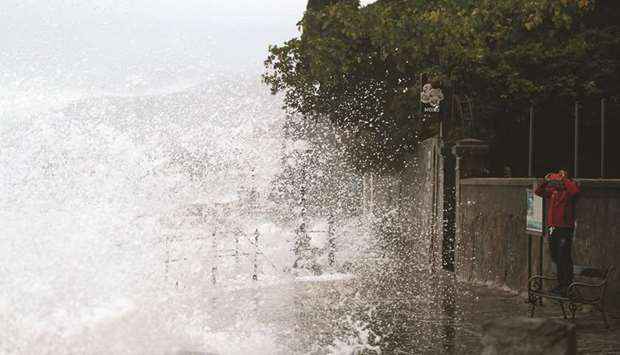The lagoon city’s Saint Mark’s Square remained under water for a second day while the adjacent Saint Mark’s Basilica was also inundated, with its baptistery totally flooded and its historic, mosaic floors covered by 90cm (2.95’) of water.
“The basilica has aged 20 years in just one day, and perhaps I am being overly optimistic about that,” said Carlo Tesserin, the church’s chief administrator.
Italian media said that it was the second time this century that the basilica had been flooded, and just the fifth time it had seen such high water within the body of the cathedral in its 1,000-year history.
“It is becoming ever more difficult for us and indeed could become impossible for us to repair the damage, especially in an age of climate change,” Tesserin said.
Art experts were racing to evaluate the damage to mosaics in Saint Mark’s Basilica after the Bapistry and Zen Chapel flooded.
Two paintings by Spanish artist Joan Miro were damaged at the Palazzo Zaguri, where they had been waiting to be hung.
Widespread damage was also reported in towns and cities in the north, south and centre of Italy.
Many of the 11 deaths were caused by falling trees as winds as strong as 150kph (90mph) whipped the country.
Authorities reported that a woman died when her home was engulfed by a mudslide in the northern region of Trentino, a man was killed in the northeastern Veneto region by a falling tree, and a firefighter died during relief operations in South Tyrol.
Elsewhere, a man was killed while kitesurfing on Monday near the town of Cattolica on the Adriatic coast, while the body of another man was recovered yesterday in Lake Levico in the north.
A man was also missing at sea off Calabria in the southwest.
Italian media reported that around 170 people, tourists and hotel staff, were stranded by heavy snowfall at the Stelvio Pass on the Swiss border.
Meanwhile in Friuli Venezia Giulia, local authorities said some 23,000 people were without power.
One of the hardest hit regions was Liguria, in the northwest.
“We thought the danger would come from the mountains, we thought the problem would be landslides,” said Liguria head Giovanni Toti, adding: “Instead, we get a coastal storm surge the likes of which we’ve never seen.”
The breakwater walls in the chic seaside resort of Rapallo were destroyed by pounding waves, allowing in a surge of water that toppled dozens of luxury yachts and inflicted heavy damage on the port area.
“It was like a tsunami,” one stunned port worker was quoted as saying by Italian media.
Local media reported that a yacht owned by the family of former prime minister Silvio Berlusconi was one of those badly damaged.
The nearby resort town of Portofino was cut off by a landslide while video showed sea water pouring through the picturesque fishing village of Vernazza further to the south.
The weather was expected to improve later in the day and today, “giving the country a truce” an official from the civil protection agency told Reuters.
Meanwhile, heavy snowfall across south-central France, with up to 40cm (16”) falling in some towns and villages, caused chaos on the roads and knocked out electricity to nearly 200,000 homes, authorities said yesterday.
Another 21,000 homes were also cut off on the Mediterranean island of Corsica, which was placed on red alert on Monday for powerful winds, shutting its airports and ports.
More than 1,000 drivers were trapped in their cars for the night in the mountains of the Massif Central region as the roads were engulfed in snowstorms.
Another 400 had to spend the night in train carriages at the main station in the eastern city of Lyon after heavy snow blocked the tracks.
Croatia’s Adriatic coast has also been battered by gale-force winds and heavy rains that have flooded streets, cut off power and ensnared road and maritime traffic.
A Slovenian surfer has been missing since Monday in the sea off of Croatia’s Umag city, on the northern Istria peninsula.
In Delnice, in western Croatia, 156 litres of water per square metre were measured within 24 hours.
In Slovenia, the storm knocked down trees and caused minor flooding in places.
A red alert remains in some places due to the swelling Drava river, the STA news agency said.
In Spain, over 100 soldiers were helping electrical repair crews to reach isolated areas of the northern region of Asturias, blanketed by heavy snowfall at the weekend.
Storms have also swept into Switzerland, buffeting the Ticino region near the Italian border overnight, according to public broadcaster RTS.
Roads were blocked by fallen trees and flooding, while strong winds ripped roof sections off buildings, including in Giubiasco where police said part of a firm’s roof had smashed into a moving train and a house, without causing injury.
In southern Austria, authorities have deployed hundreds of mobile anti-flooding dams as rivers burst their banks, while in the city of Salzburg a roof section from the mediaeval ramparts flew off in high winds.
In Malta, rough seas claimed the lives of two people: a German woman who was diving near the island of Gozo, and an 85-year-old fisherman, who last year had received a prize for rescuing a drowning man.
A European Commission spokeswoman sent condolences to Italy and said that Brussels was “ready to provide any support and aid that it can”.
Europe wasn’t all miserable, however.
Berlin was unseasonably warm at 19° Celsius, while Warsaw saw the temperature hover around 21°C.
Bucharest was balmy at 23°C.

